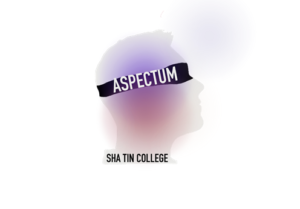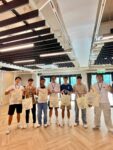Y12 CAS – Aspectum

CAS stands for Creativity, Action, and Service, and it is one of three essential elements that every student must complete to receive the IB Diploma. While not formally assessed, CAS provides opportunities for students to enhance their personal and interpersonal development through hands-on learning.
One of the components of CAS is a ‘CAS Project’, a collaborative series of student-initiated CAS experiences over several months engaging students in one or more CAS strands (creativity, activity, and service). Following the five CAS stages of Investigation, Preparation, Demonstration, Action, and Reflection, students can explore their passions whilst challenging themselves to initiate purposeful action around defined goals. The following months will bring a series of interviews where the STC Media Team interviews different students around school to highlight their CAS projects and initiatives.
This week, Aspectum – consisting of Eric Chan, Karen Lau, Kapo Cheung, Takaaki Tajima, Jessica Tapley, Tanish Mukhopadhyay, Allison Chiu and Justin Kuong – speaks to the STC Media Team about their CAS project. Aspectum is a group of students looking to raise awareness for visual disabilities so the STC community can better understand the experiences of People of Differences, or people with visual or auditory impairments.
Can you introduce your CAS project? What is the purpose of your CAS project?
As the number of people with visual impairments worldwide increases each year, we became interested in learning more about living with visual impairments. We realised that many people are unaware of the struggles and challenges people with visual impairments face and have witnessed many cases around Hong Kong where people struggled to help People of Differences. People tend to be unsure of how to approach people with impairments which may end up causing more harm than good.
Hence, we created this CAS project as we believe it is essential to educate everyone in society about the difficulties that People of Differences face in their daily lives. As a group, we had the opportunity to visit Dialogue Experience HK (the NGO we collaborate with) and participate in one of their activities called Dialogue in the Dark. This experience showed us how impactful and effective hands-on activities are in aiding the understanding of visual impairments, inspiring us to create our activities.
We intend to increase awareness and empathy by providing a range of activities for students and teachers. Our first activity is to run a braille club to teach students how to read and write in braille and information about common visual impairments. Another event is to visit Dialogue HK, where the STC community has the opportunity to experience Dialogue’s original Dialogue in the Dark experience. Thus, the STC community can better understand the difficulties and minor inconveniences the visually impaired face.
What impact/outcome do you hope your CAS project will have on the school community?
Our main goal is to allow more students to become aware of Dialogue Experience HK’s actions and encourage them to try out more immersive activities themselves to gain firsthand experience of the challenges People of Difference face. We also hope that our school community can expand their knowledge of approaching visually impaired people and utilise our abilities and skills to support them, becoming more empathetic. By collaborating with Dialogue Experience, we also hope to encourage students to reach out to and collaborate more with new and smaller NGOs when exploring their projects, recognising that no matter the size and popularity of the organisation, everyone is in power to help make a difference. As a team, we are very excited about what this project could grow and become, and we hope that Aspectum can become a yearly CAS project within STC that prospers.
Any changes due to COVID-19? How have you adapted?
COVID-19 restrictions mean that we cancelled all in-person experiences and activities, so we cannot take students to Dialogue Experience HK for trips. Regardless, we have adapted to the current situation by creating one adjustment to our project: switching our braille club to online activity to ensure that we can carry on with our project. We also managed to adapt our communication and collaboration with Dialogue NGO to an online mode of delivery.
What are some common misconceptions about visually impaired people, and how do these influence our perception of them?
There are many misconceptions about visual impairments and what visually impaired people can or cannot do in our community. For example, people often believe that People of Differences cannot cook a meal, clean their house, take care of children, or have a job – this is simply not true. These common misconceptions lead many into thinking that People of Differences are less capable and less regular than others, disregarding them completely. Some people even perceive People of Differences as less approachable and unfriendly just because of their impairments, avoiding talking about these issues and supporting those in need. Although daily tasks may be a more challenging process for some people with visual impairments, they could easily overcome these difficulties with training from professionals and support from the community.
Common misconception: everyone with visual impairments are completely blind and can only see darkness.
Reality: There are five visual impairments, including central vision, loss of peripheral vision and blurred vision; only approximately 18% of people are completely blind. Different visual impairments lead to a range in what people can see, and people who are blind can still differentiate between light and dark.
Common misconception: Most people with visual impairments are proficient in braille and own a guide dog.
Reality: Only a tiny percentage of visually impaired people have learned braille and white canes are more common travel tools than guide dogs.
What are some challenges People of Differences might face? What can students do to help make communities more accessible?
People with Differences may face many challenges from basic daily activities, such as travelling and shopping, to communicating with others and building their social groups. One common challenge they face when shopping is paying the correct amount. We learnt that some people with visual impairments have specific compartments and sections in their wallets to help them separate and organise their money, aiding them with paying the correct amount. However, it may be hard for them to identify whether or not workers give them back the right amount of change, which is why it is common for People of Differences to pay the exact amount when purchasing items to avoid any complications.
Another common challenge they face while living alongside a fast-paced lifestyle in a busy city is interaction with others. People can quickly become impatient: workers are often unwilling to provide extra help, and unempathetic customers complain about the hold up in lines as People of Differences try to purchase items.
Another challenge People with Differences may face difficulties adapting to the new lifestyle and learning new skills. Many people lose sight and become visually impaired due to accidents or serious illnesses. Adjusting from having the ability to see and having their vision taken away is always a problematic change.
But how can you help? We can educate ourselves about People of Differences to support and aid them when required. We can also help spread awareness about the stories of People of Differences by participating in informative events organised by NGOs. Lastly, we can help by being more empathetic and understanding of the challenges faced by People with Differences.
Edited by: Kadence Wong


